TOYOTA CAMRY 2020 Owners Manual (in English)
Manufacturer: TOYOTA, Model Year: 2020, Model line: CAMRY, Model: TOYOTA CAMRY 2020Pages: 620, PDF Size: 12.95 MB
Page 491 of 620
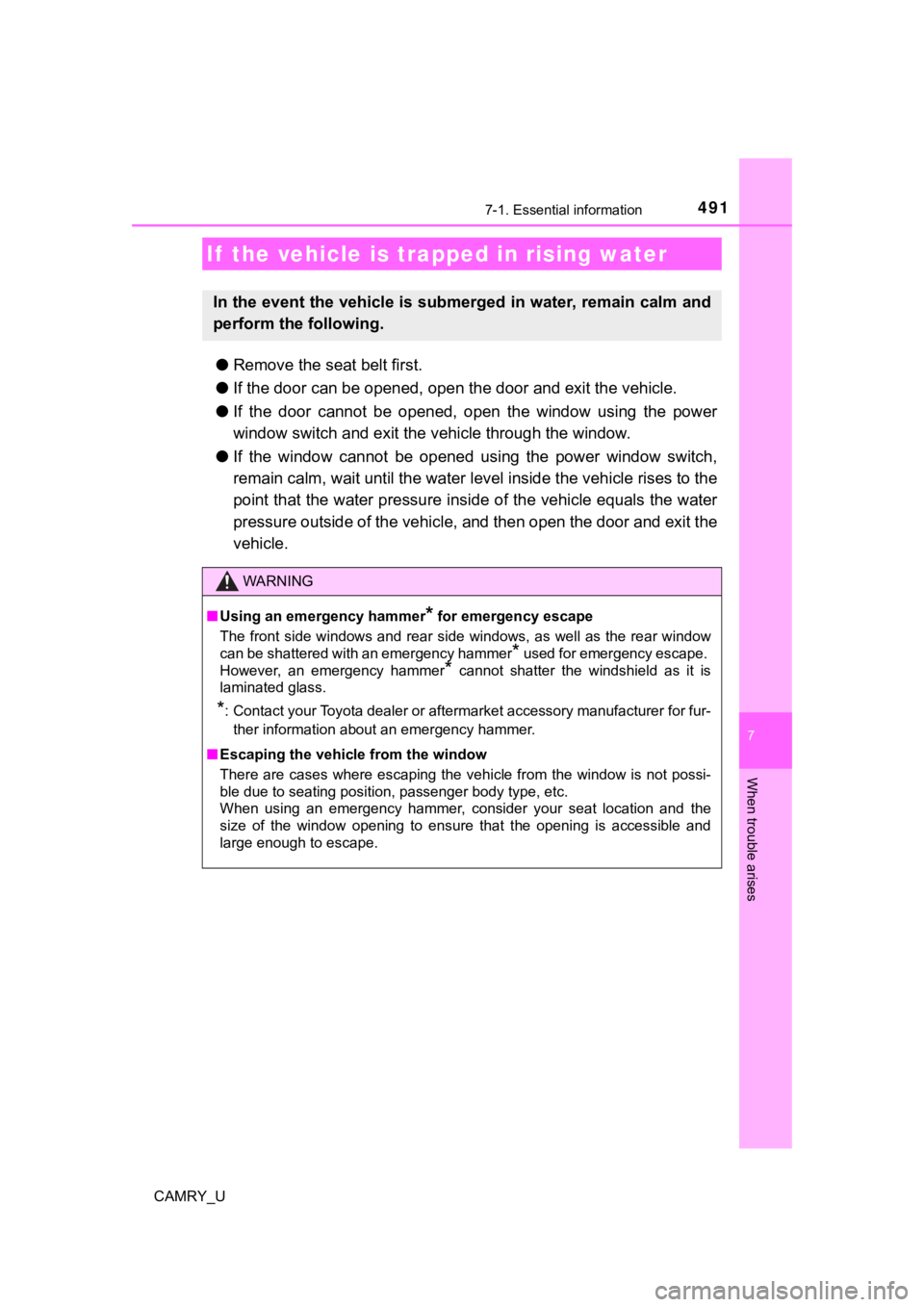
4917-1. Essential information
7
When trouble arises
CAMRY_U
ŌŚÅRemove the seat belt first.
ŌŚÅ If the door can be opened, open the door and exit the vehicle.
ŌŚÅ If the door cannot be opened, open the window using the power
window switch and exit the vehicle through the window.
ŌŚÅ If the window cannot be opened using the power window switch,
remain calm, wait until the water level inside the vehicle rise s to the
point that the water pressure i nside of the vehicle equals the water
pressure outside of the vehicl e, and then open the door and exi t the
vehicle.
If the vehicle is trapped in rising water
In the event the vehicle is submerged in water, remain calm and
perform the following.
WARNING
Ō¢Ā Using an emergency hammer* for emergency escape
The front side windows and rear side windows, as well as the re ar window
can be shattered with an emergency hammer
* used for emergency escape.
However, an emergency hammer
* cannot shatter the windshield as it is
laminated glass.
*: Contact your Toyota dealer or aftermarket accessory manufacturer for fur-
ther information about an emergency hammer.
Ō¢Ā Escaping the vehicle from the window
There are cases where escaping the vehicle from the window is n ot possi-
ble due to seating position, passenger body type, etc.
When using an emergency hammer, consider your seat location and the
size of the window opening to ensure that the opening is accessible and
large enough to escape.
Page 492 of 620
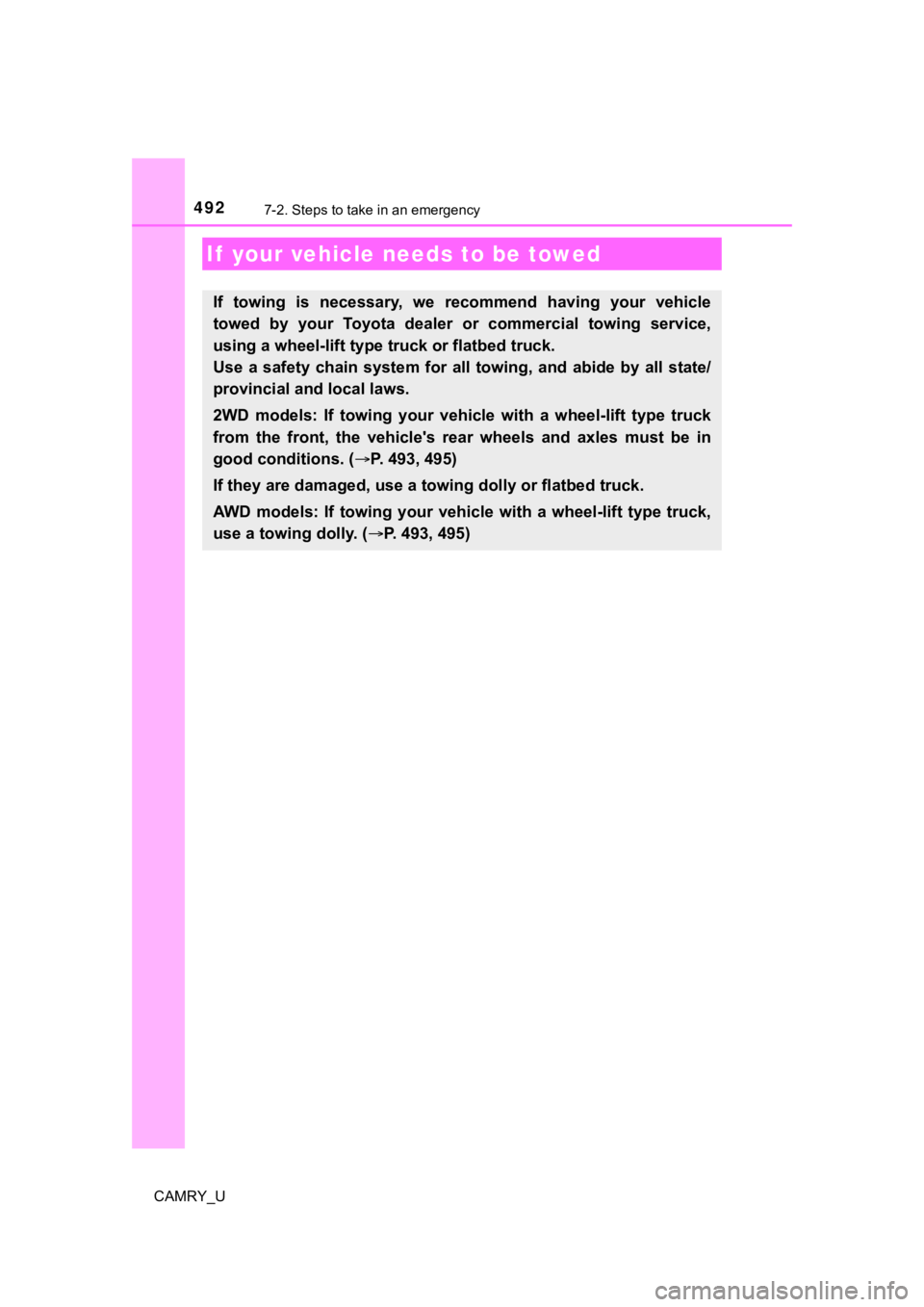
492
CAMRY_U
7-2. Steps to take in an emergency
If your vehicle needs to be towed
If towing is necessary, we recommend having your vehicle
towed by your Toyota dealer or commercial towing service,
using a wheel-lift type t ruck or flatbed truck.
Use a safety chain system for all towing, and abide by all stat e/
provincial and local laws.
2WD models: If towing your vehic le with a wheel-lift type truck
from the front, the vehicle's rear wheels and axles must be in
good conditions. ( ’é«P. 493, 495)
If they are damaged, use a to wing dolly or flatbed truck.
AWD models: If towing your vehicle with a wheel-lift type truck ,
use a towing dolly. ( ’é«P. 493, 495)
Page 493 of 620
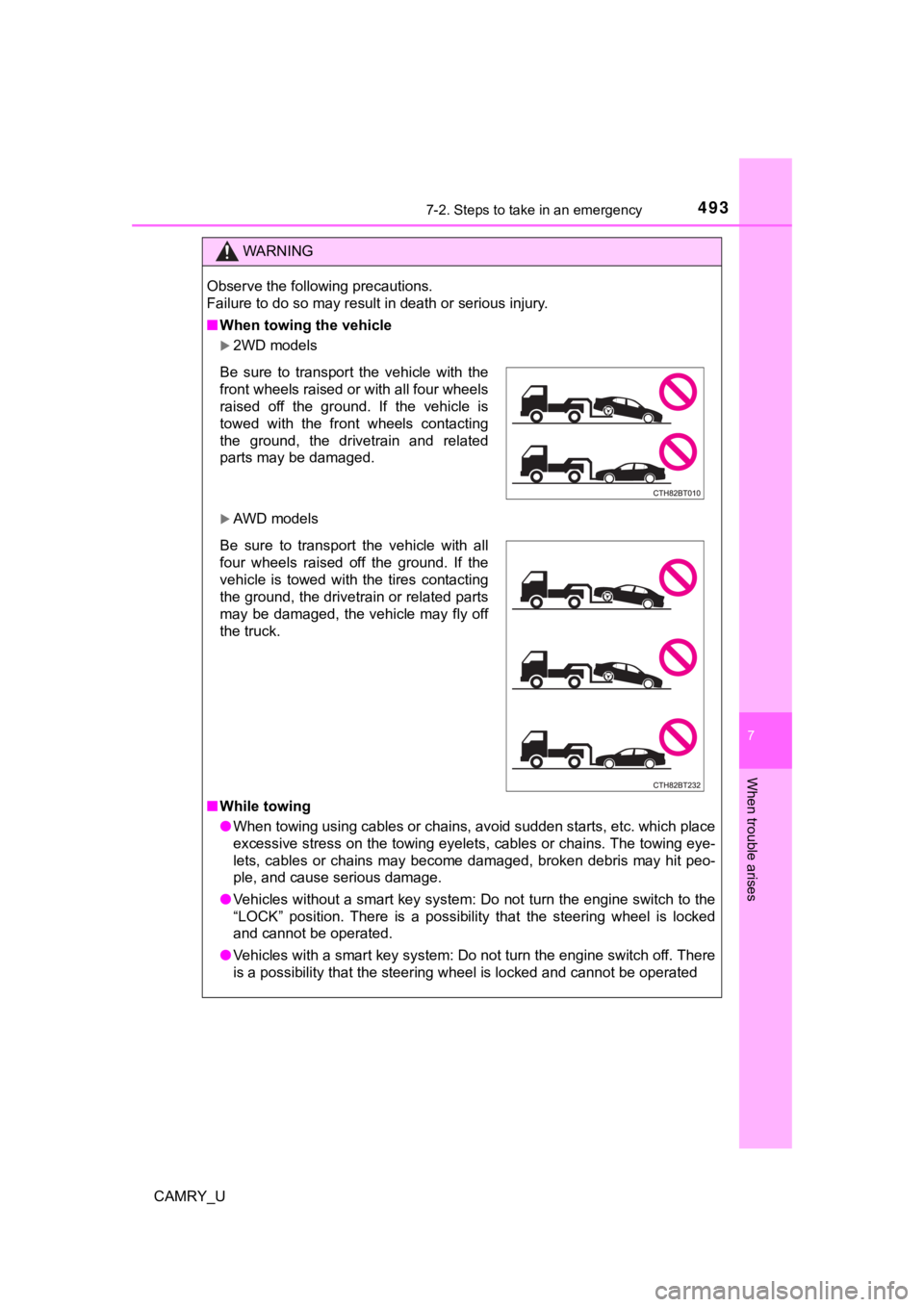
4937-2. Steps to take in an emergency
CAMRY_U
7
When trouble arises
WARNING
Observe the following precautions.
Failure to do so may result in death or serious injury.
Ō¢ĀWhen towing the vehicle
’üĄ2WD models
’üĄAWD models
Ō¢Ā While towing
ŌŚÅ When towing using cables or chains, avoid sudden starts, etc. w hich place
excessive stress on the towing eyelets, cables or chains. The towing eye-
lets, cables or chains may become damaged, broken debris may hit peo-
ple, and cause serious damage.
ŌŚÅ Vehicles without a smart key system: Do not turn the engine switch to the
ŌĆ£LOCKŌĆØ position. There is a possibility that the steering wheel is locked
and cannot be operated.
ŌŚÅ Vehicles with a smart key system: Do not turn the engine switch off. There
is a possibility that the steering wheel is locked and cannot be operated
Be sure to transport the vehicle with the
front wheels raised or with all four wheels
raised off the ground. If the vehicle is
towed with the front wheels contacting
the ground, the drivetrain and related
parts may be damaged.
Be sure to transport the vehicle with all
four wheels raised off the ground. If the
vehicle is towed with the tires contacting
the ground, the drivetrain or related parts
may be damaged, the vehicle may fly off
the truck.
Page 494 of 620
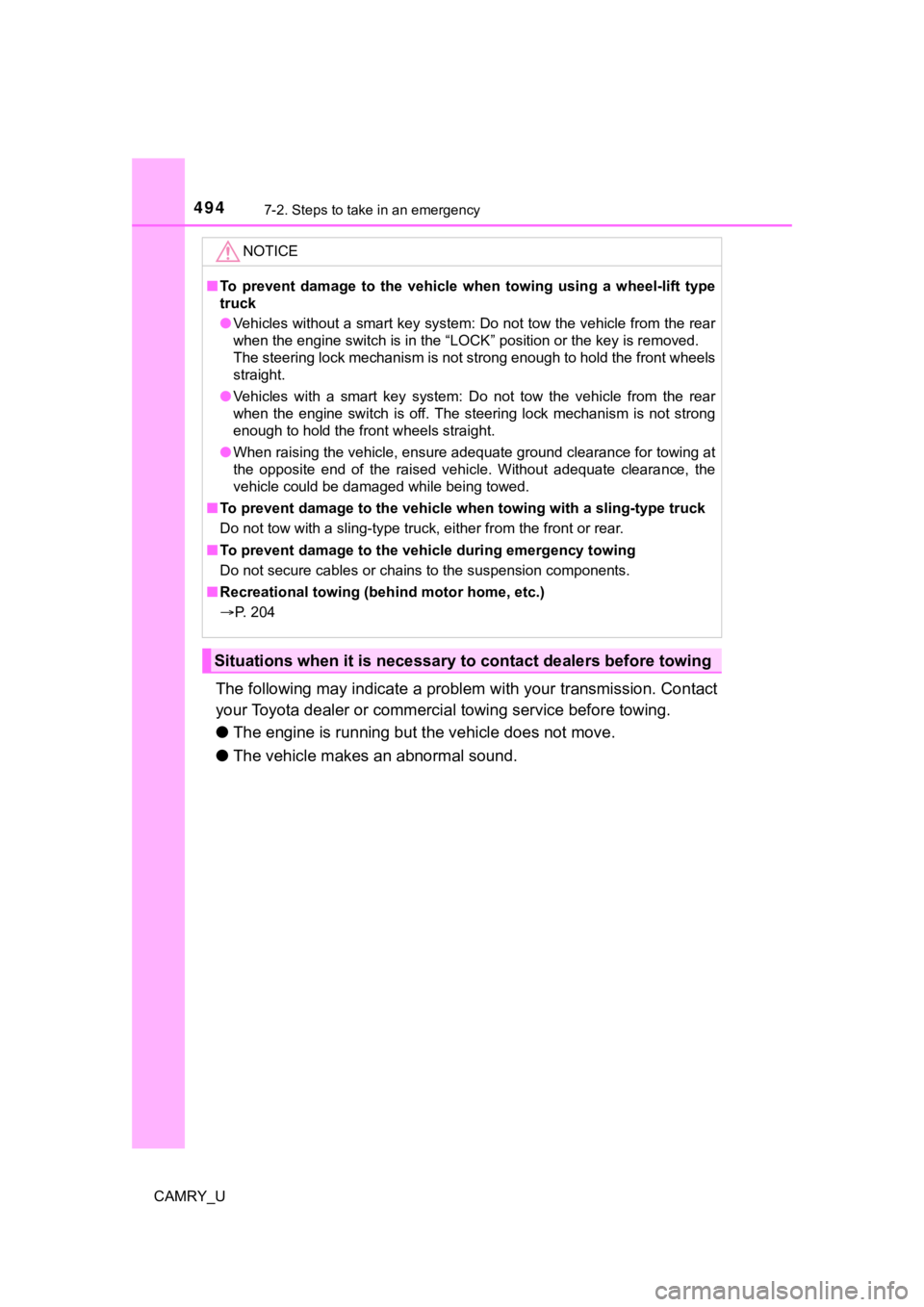
4947-2. Steps to take in an emergency
CAMRY_U
The following may indicate a problem with your transmission. Contact
your Toyota dealer or commercial towing service before towing.
ŌŚÅ The engine is running but t he vehicle does not move.
ŌŚÅ The vehicle makes an abnormal sound.
NOTICE
Ō¢ĀTo prevent damage to the vehicle when towing using a wheel-lift type
truck
ŌŚÅ Vehicles without a smart key system: Do not tow the vehicle fro m the rear
when the engine switch is in the ŌĆ£LOCKŌĆØ position or the key is removed.
The steering lock mechanism is not strong enough to hold the front wheels
straight.
ŌŚÅ Vehicles with a smart key system: Do not tow the vehicle from the rear
when the engine switch is off. The steering lock mechanism is n ot strong
enough to hold the front wheels straight.
ŌŚÅ When raising the vehicle, ensure adequate ground clearance for towing at
the opposite end of the raised vehicle. Without adequate clearance, the
vehicle could be damaged while being towed.
Ō¢Ā To prevent damage to the vehicle when towing with a sling-type truck
Do not tow with a sling-type truck, either from the front or re ar.
Ō¢Ā To prevent damage to the vehic le during emergency towing
Do not secure cables or chains to the suspension components.
Ō¢Ā Recreational towing (behind motor home, etc.)
’é« P. 204
Situations when it is necessary to contact dealers before towing
Page 495 of 620
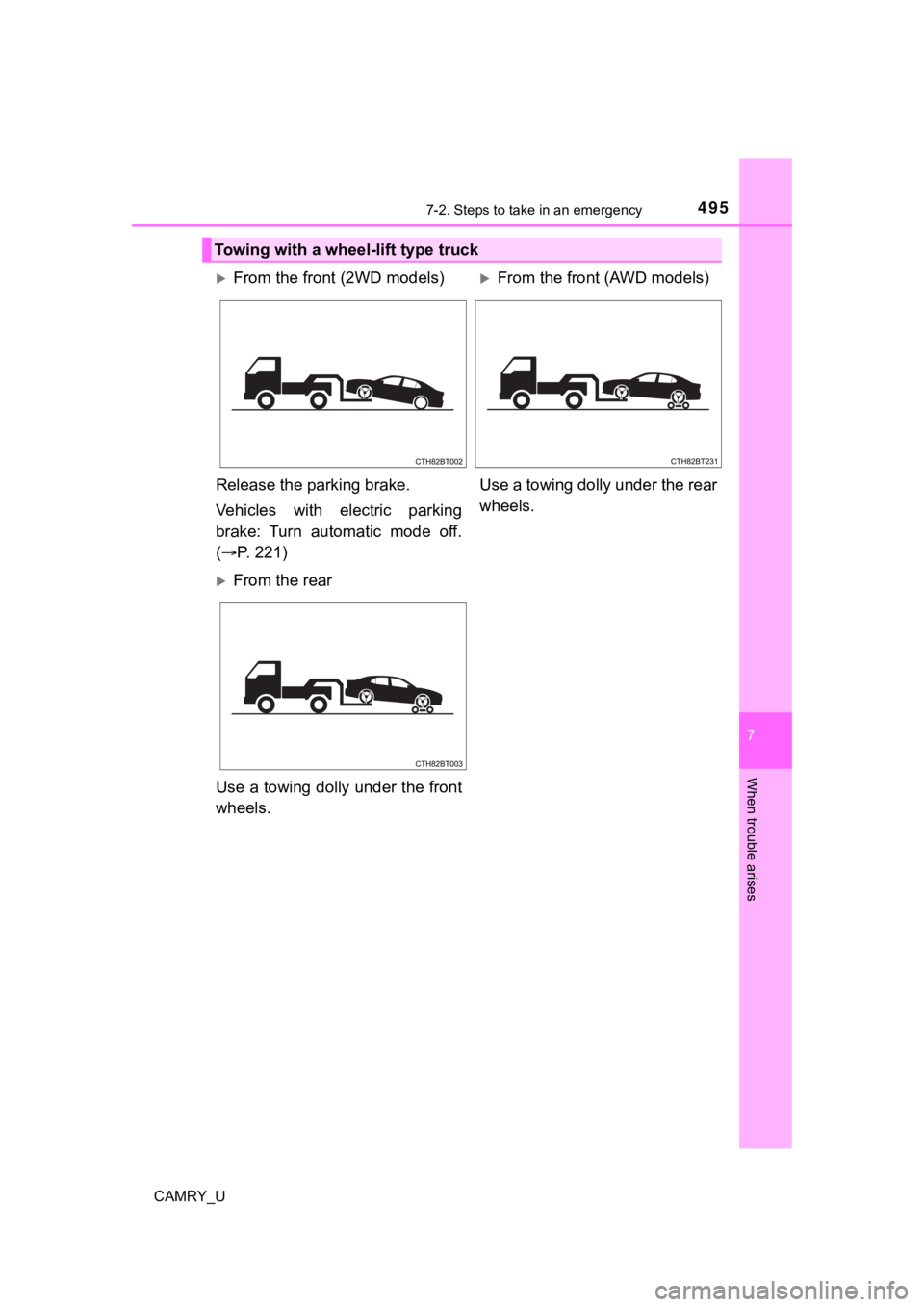
4957-2. Steps to take in an emergency
CAMRY_U
7
When trouble arises
Towing with a wheel-lift type truck
’üĄFrom the front (2WD models)’üĄFrom the front (AWD models)
Release the parking brake.
Vehicles with electric parking
brake: Turn automatic mode off.
( ’é« P. 221) Use a towing dolly under the rear
wheels.
’üĄFrom the rear
Use a towing dolly under the front
wheels.
Page 496 of 620
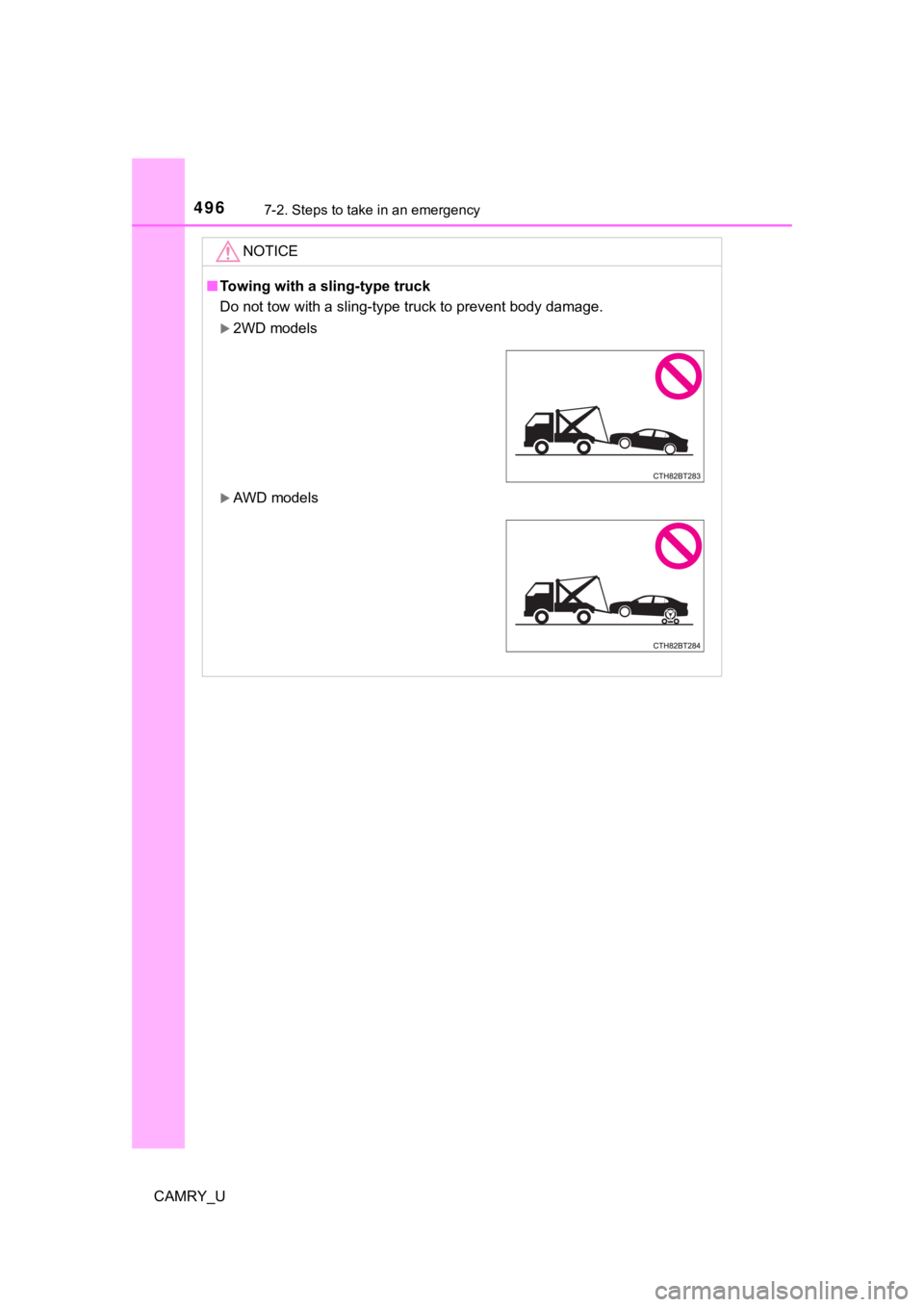
4967-2. Steps to take in an emergency
CAMRY_U
NOTICE
Ō¢ĀTowing with a sling-type truck
Do not tow with a sling-type truck to prevent body damage.
’üĄ2WD models
’üĄAWD models
Page 497 of 620
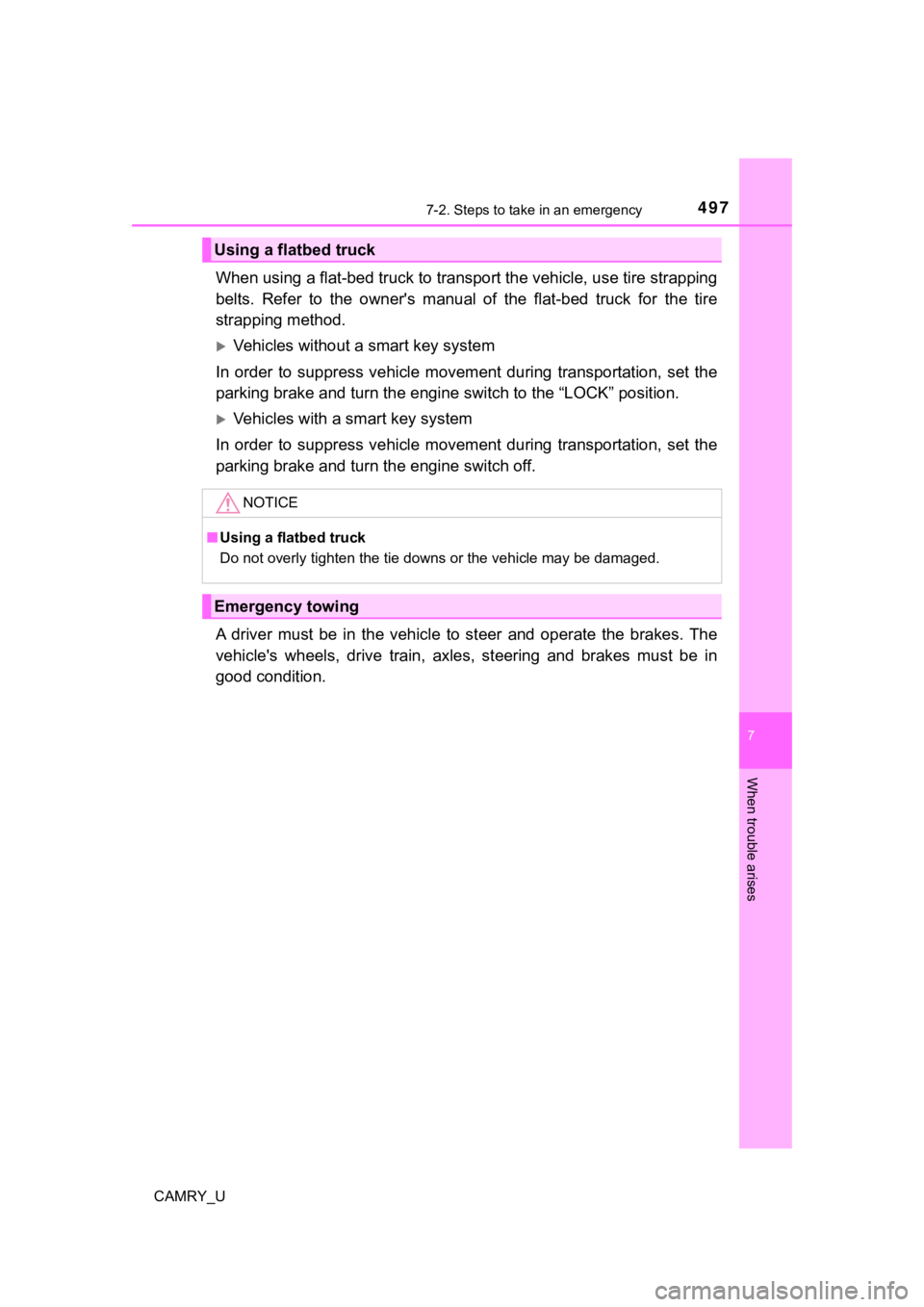
4977-2. Steps to take in an emergency
CAMRY_U
7
When trouble arises
When using a flat-bed truck to transport the vehicle, use tire strapping
belts. Refer to the owner's manual of the flat-bed truck for th e tire
strapping method.
’üĄVehicles without a smart key system
In order to suppress vehicle movement during transportation, se t the
parking brake and turn the engine switch to the ŌĆ£LOCKŌĆØ position .
’üĄVehicles with a smart key system
In order to suppress vehicle movement during transportation, se t the
parking brake and turn the engine switch off.
A driver must be in the vehicle to steer and operate the brakes . The
vehicle's wheels, drive train, axles, steering and brakes must be in
good condition.
Using a flatbed truck
NOTICE
Ō¢Ā Using a flatbed truck
Do not overly tighten the tie downs or the vehicle may be damag ed.
Emergency towing
Page 498 of 620
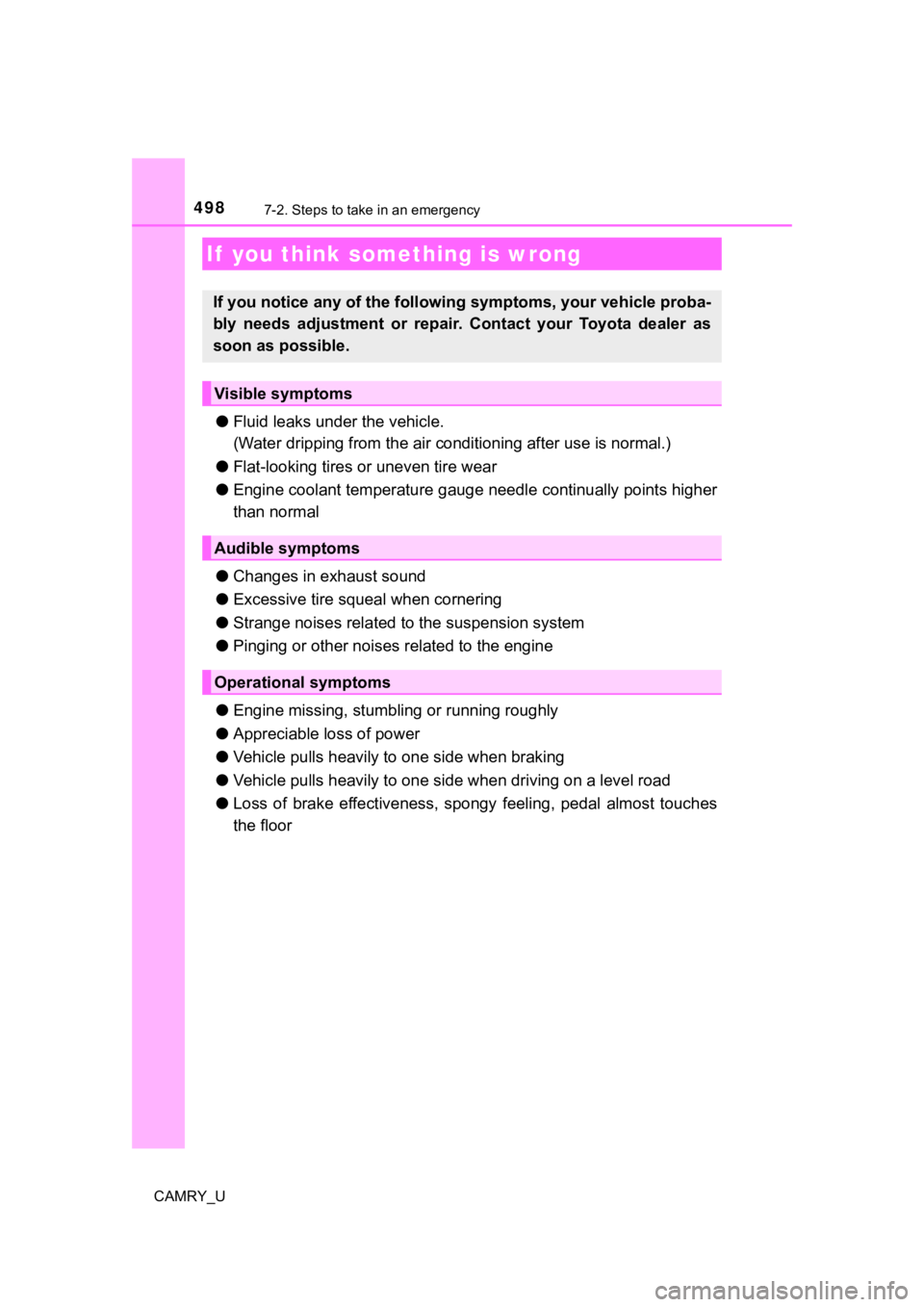
4987-2. Steps to take in an emergency
CAMRY_U
ŌŚÅFluid leaks un der the vehicle.
(Water dripping from the air conditioning a fter use is normal.)
ŌŚÅ Flat-looking tires or uneven tire wear
ŌŚÅ Engine coolant temperature gauge needle continually points high er
than normal
ŌŚÅ Changes in exhaust sound
ŌŚÅ Excessive tire squeal when cornering
ŌŚÅ Strange noises related to the suspension system
ŌŚÅ Pinging or other noises related to the engine
ŌŚÅ Engine missing, stumb ling or running roughly
ŌŚÅ Appreciable loss of power
ŌŚÅ Vehicle pulls heavily to one side when braking
ŌŚÅ Vehicle pulls heavily to one s ide when driving on a level road
ŌŚÅ Loss of brake effectiveness, spongy feeling, pedal almost touch es
the floor
If you think something is wrong
If you notice any of the followi ng symptoms, your vehicle proba -
bly needs adjustment or repair. Contact your Toyota dealer as
soon as possible.
Visible symptoms
Audible symptoms
Operational symptoms
Page 499 of 620
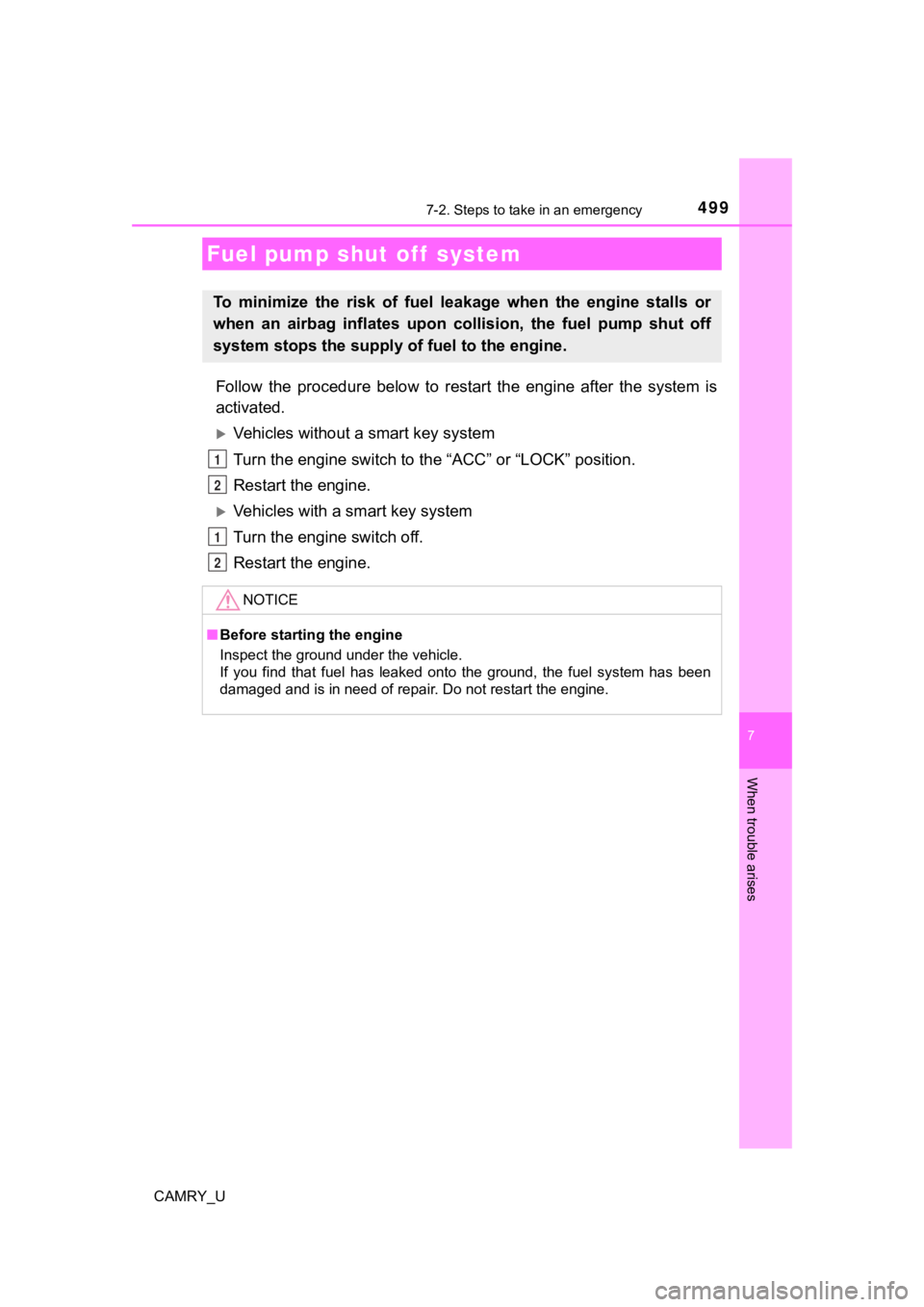
4997-2. Steps to take in an emergency
CAMRY_U
7
When trouble arises
Follow the procedure below to restart the engine after the system is
activated.
’üĄVehicles without a smart key system
Turn the engine switch to the ŌĆ£ACCŌĆØ or ŌĆ£LOCKŌĆØ position.
Restart the engine.
’üĄVehicles with a smart key system
Turn the engine switch off.
Restart the engine.
Fuel pump shut off system
To minimize the risk of fuel leakage when the engine stalls or
when an airbag inflates upon collision, the fuel pump shut off
system stops the supply of fuel to the engine.
NOTICE
Ō¢Ā Before starting the engine
Inspect the ground under the vehicle.
If you find that fuel has leaked onto the ground, the fuel system has been
damaged and is in need of repair. Do not restart the engine.
1
2
1
2
Page 500 of 620
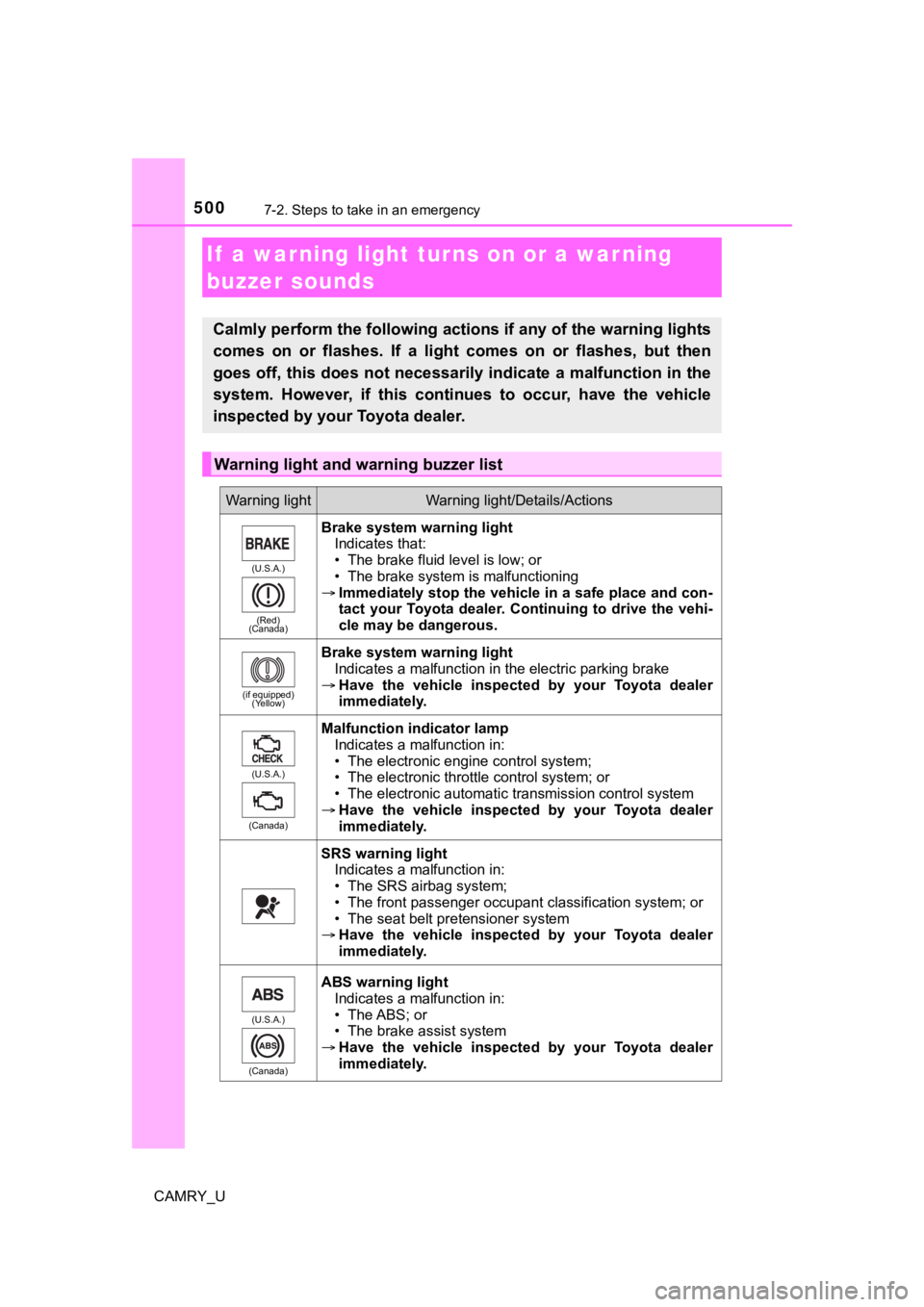
5007-2. Steps to take in an emergency
CAMRY_U
If a warning light turns on or a war ning
buzzer sounds
Calmly perform the following actions if any of the warning ligh ts
comes on or flashes. If a light comes on or flashes, but then
goes off, this does not necessarily indicate a malfunction in the
system. However, if this continues to occur, have the vehicle
inspected by your Toyota dealer.
Warning light and w arning buzzer list
Warning lightWarning light/Details/Actions
(U.S.A.)
(Red)
(Canada)
Brake system warning light
Indicates that:
ŌĆó The brake fluid level is low; or
ŌĆó The brake system is malfunctioning
’é« Immediately stop the vehicle in a safe place and con-
tact your Toyota dealer. Continuing to drive the vehi-
cle may be dangerous.
(if equipped)
(Yellow)
Brake system warning light
Indicates a malfunction in the electric parking brake
’é« Have the vehicle inspected by your Toyota dealer
immediately.
(U.S.A.)
(Canada)
Malfunction indicator lamp Indicates a malfunction in:
ŌĆó The electronic engine control system;
ŌĆó The electronic throttle control system; or
ŌĆó The electronic automatic transmission control system
’é« Have the vehicle inspected by your Toyota dealer
immediately.
SRS warning light
Indicates a malfunction in:
ŌĆó The SRS airbag system;
ŌĆó The front passenger occupant classification system; or
ŌĆó The seat belt pretensioner system
’é« Have the vehicle inspected by your Toyota dealer
immediately.
(U.S.A.)
(Canada)
ABS warning light Indicates a malfunction in:
ŌĆó The ABS; or
ŌĆó The brake assist system
’é« Have the vehicle inspected by your Toyota dealer
immediately.